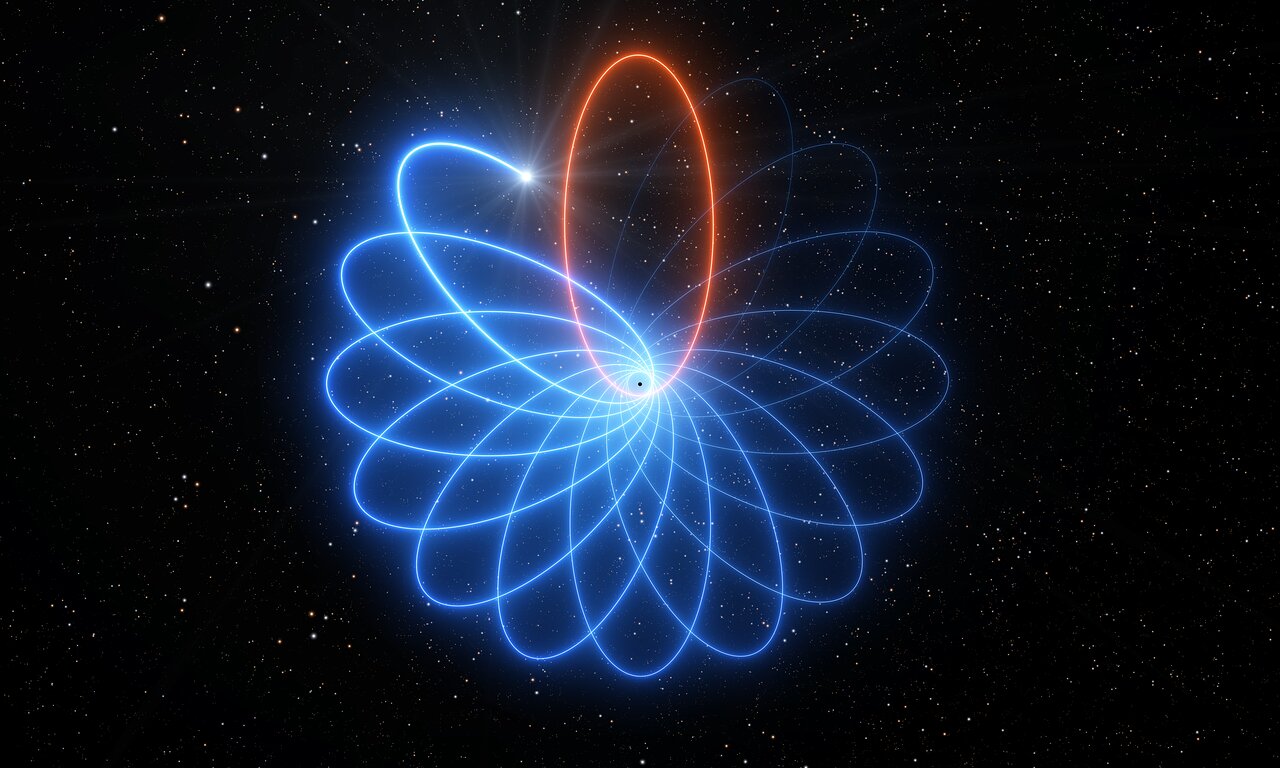A 16th April 2020 press release by the European Southern observatory (ESO) reports :-
ESO wrote:
Observations made with ESO’s Very Large Telescope (VLT) have revealed for the first time that a star orbiting the supermassive black hole at the centre of the Milky Way moves just as predicted by Einstein’s general theory of relativity. Its orbit is shaped like a rosette and not like an ellipse as predicted by Newton's theory of gravity. This long-sought-after result was made possible by increasingly precise measurements over nearly 30 years, which have enabled scientists to unlock the mysteries of the behemoth lurking at the heart of our galaxy.
“Einstein’s General Relativity predicts that bound orbits of one object around another are not closed, as in Newtonian Gravity, but precess forwards in the plane of motion. This famous effect — first seen in the orbit of the planet Mercury around the Sun — was the first evidence in favour of General Relativity. One hundred years later we have now detected the same effect in the motion of a star orbiting the compact radio source Sagittarius A* at the centre of the Milky Way. This observational breakthrough strengthens the evidence that Sagittarius A* must be a supermassive black hole of 4 million times the mass of the Sun,” says Reinhard Genzel, Director at the Max Planck Institute for Extraterrestrial Physics (MPE) in Garching, Germany and the architect of the 30-year-long programme that led to this result.
Located 26 000 light-years from the Sun, Sagittarius A* and the dense cluster of stars around it provide a unique laboratory for testing physics in an otherwise unexplored and extreme regime of gravity. One of these stars, S2, sweeps in towards the supermassive black hole to a closest distance less than 20 billion kilometres (one hundred and twenty times the distance between the Sun and Earth), making it one of the closest stars ever found in orbit around the massive giant. At its closest approach to the black hole, S2 is hurtling through space at almost three percent of the speed of light, completing an orbit once every 16 years. “After following the star in its orbit for over two and a half decades, our exquisite measurements robustly detect S2’s Schwarzschild precession in its path around Sagittarius A*,” says Stefan Gillessen of the MPE, who led the analysis of the measurements published today in the journal Astronomy & Astrophysics.
Most stars and planets have a non-circular orbit and therefore move closer to and further away from the object they are rotating around. S2’s orbit precesses, meaning that the location of its closest point to the supermassive black hole changes with each turn, such that the next orbit is rotated with regard to the previous one, creating a rosette shape. General Relativity provides a precise prediction of how much its orbit changes and the latest measurements from this research exactly match the theory. This effect, known as Schwarzschild precession, had never before been measured for a star around a supermassive black hole.
The study with ESO’s VLT also helps scientists learn more about the vicinity of the supermassive black hole at the centre of our galaxy. “Because the S2 measurements follow General Relativity so well, we can set stringent limits on how much invisible material, such as distributed dark matter or possible smaller black holes, is present around Sagittarius A*. This is of great interest for understanding the formation and evolution of supermassive black holes,” say Guy Perrin and Karine Perraut, the French lead scientists of the project.
This result is the culmination of 27 years of observations of the S2 star using, for the best part of this time, a fleet of instruments at ESO’s VLT, located in the Atacama Desert in Chile. The number of data points marking the star’s position and velocity attests to the thoroughness and accuracy of the new research: the team made over 330 measurements in total, using the GRAVITY, SINFONI and NACO instruments. Because S2 takes years to orbit the supermassive black hole, it was crucial to follow the star for close to three decades, to unravel the intricacies of its orbital movement.
The research was conducted by an international team led by Frank Eisenhauer of the MPE with collaborators from France, Portugal, Germany and ESO. The team make up the GRAVITY collaboration, named after the instrument they developed for the VLT Interferometer, which combines the light of all four 8-metre VLT telescopes into a super-telescope (with a resolution equivalent to that of a telescope 130 metres in diameter). The same team reported in 2018 another effect predicted by General Relativity: they saw the light received from S2 being stretched to longer wavelengths as the star passed close to Sagittarius A*. “Our previous result has shown that the light emitted from the star experiences General Relativity. Now we have shown that the star itself senses the effects of General Relativity,” says Paulo Garcia, a researcher at Portugal’s Centre for Astrophysics and Gravitation and one of the lead scientists of the GRAVITY project.
With ESO’s upcoming Extremely Large Telescope, the team believes that they would be able to see much fainter stars orbiting even closer to the supermassive black hole. “If we are lucky, we might capture stars close enough that they actually feel the rotation, the spin, of the black hole,” says Andreas Eckart from Cologne University, another of the lead scientists of the project. This would mean astronomers would be able to measure the two quantities, spin and mass, that characterise Sagittarius A* and define space and time around it. “That would be again a completely different level of testing relativity," says Eckart.
Press release including artist impression here :-
https://www.eso.org/public/news/eso2006/?lang

![[Logo]](/forum/templates/default/images/logo.jpg)